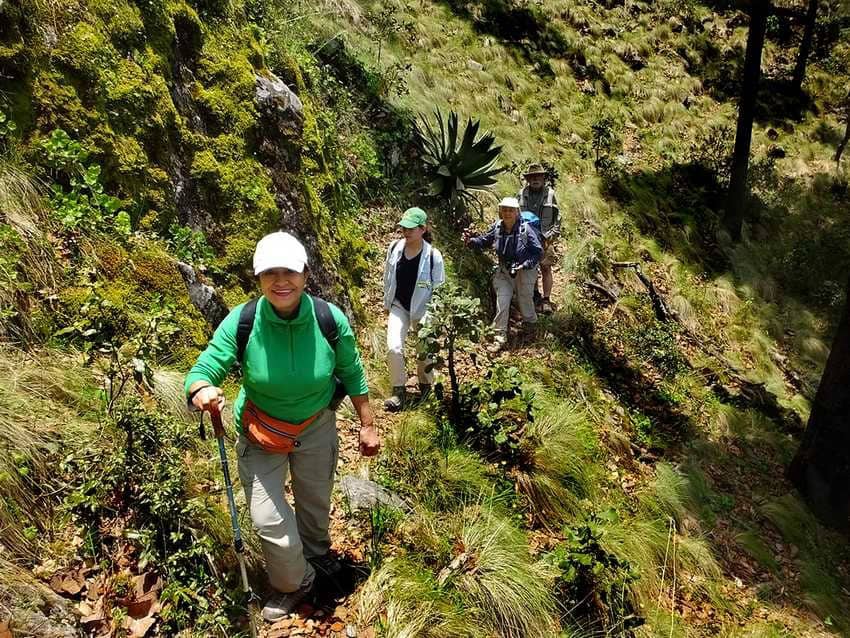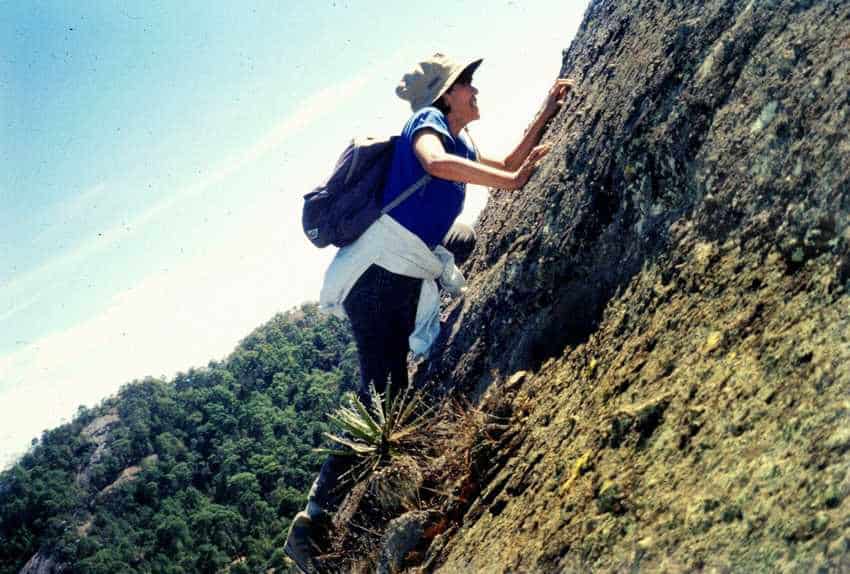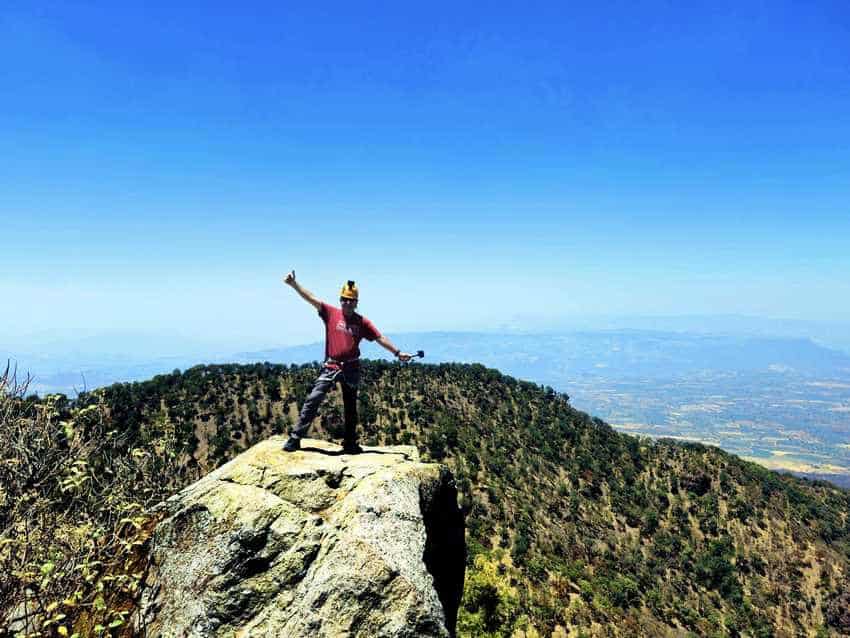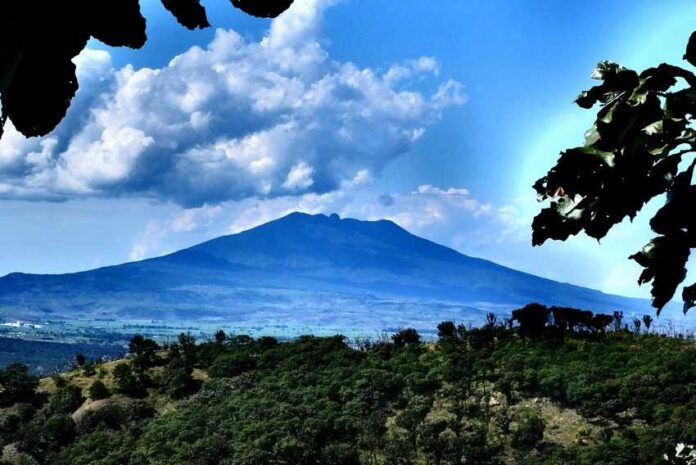What’s the most exciting thing to do when you visit Guadalajara? Think Tequila — the volcano, of course!
Tequila volcano is, after all, the biggest thing around, covering an area of some 34,660 hectares (134 square miles) and peaking at 2920 meters (9580 feet) above sea level.

Wherever you go in the region, there it is, commanding the horizon, the classic stratovolcano par excellence, and, rising from its crater like an obelisk: a 50-meter-tall spike, known to all as la “Tetilla,” the Nipple.
Fortunately, a cobblestone road was constructed long ago from the town of Tequila at the volcano’s foot, to two sets of antennas built on both sides of the crater rim.
The road to the top is 18 kilometers long — rough, winding, and steep — but a hardy, high-clearance vehicle will get you to a locked gate only two kilometers from the antennas. Here you park, and in the time-honored Mexican tradition, climb over the fence to begin your adventure.
Walking up the cobblestone road, keep your eyes open. This is a great place to spot a bizarre little carnivorous plant known as the “pinguícula” (butterwort). Many carnivorous plants have a chamber where they trap their victims, but the pinguícula is different. Check its bottom leaves, which lie on the surface of the ground. You’ll find them sticky to the touch and you may see more than one unlucky little insect stuck in place, unable to move.
Should you be climbing the mountain in the Fall, you may come across plenty of Caesar’s mushrooms. In this season you may also experience great clouds of wispy, shifting fog.
A kilometer from the locked gate, the road splits, giving you access to both sets of antennas.

About 150 meters beyond the right fork, you may be surprised to find a small watering hole, just south of the road. This cold spring seeps out of the volcano at an altitude of 2790 meters and flows all year round.
Long ago, someone must have noticed the spring and figured they would surely hit water at a nearby spot just by digging deep enough. Thus was born the legend of the Bottomless Pit of Tequila Volcano. Long ago, I was given the task of rappelling down that hole and the dubious honor of announcing that it did, in fact, have a bottom, at a mere 18 meters below the surface, with no bones or other discoveries that might enhance its story.
Beside the no-longer-bottomless pit starts a rustic trail that skirts the rim of the crater. Along it you may find a thistle called “cardo santo,” said to possess curative powers, and the Tequila Govenia, a rare and beautiful, white, ground orchid.
Recently, an international expedition of Mexicans, Canadians, and even a South African, picked their way along this trail with the intention of climbing to the very top of the spike.Here is the story of their ascent in the words of the South African member of the expedition, Jonathan Heys:
“Just as we reached the trailhead, we were lucky to see two deer and then we began walking. On all sides there was tall bunch grass, rippling in the breeze. Up ahead of us went the leader of our expedition, Chris Lloyd, a Canadian geologist, and you could see a stream of grasshoppers jumping out of the way, both to the left and to the right, as he went along — there were so many of them!
At one point we saw what looked like tennis balls — hundreds of them — scattered across the ground everywhere. ‘These,’ explained a naturalist in the group, ‘are oak apples or galls. They are created by the tree to protect gall wasps, which then grow up inside them.’

The trail now got steeper and steeper and soon we reached the base of the colossal spine that rises almost straight up from one side of the crater. This, explained Chris, was the volcano’s last gasp of lava, which took place 200,000 years ago. It hardened, and over the centuries, softer material around it was eroded away, leaving the Nipple extended 50 meters above the crater rim.
With the help of an anchor and a rope, we began climbing this spine. At a certain height, we reached a very steep area where there’s a narrow crack you can follow. Chris climbed up it first, anchored himself, and then lowered a rope, belaying each of us.
As we worked our way up, we experienced more and more wind.
Finally, we reached the top of this volcanic plug and could see mountains and mesas stretching in every direction, not to mention the agave fields which are blue and look like wetlands.
We took advantage of the beautiful view and had lunch up there. It was sunny, but thanks to the wind and the altitude, it was just the perfect temperature.
There on the peak, we found a treasure hunter’s hole. Yes, some determined soul had brought a shovel and probably a metal detector up here, hoping to strike it rich.
Finally, we made our way down, which was more interesting than climbing up because it seemed to be less safe. This involved a lot of rappelling. It was, in fact, my first non-practice rappel. I discovered that I wasn’t particularly good at this, but after all, good enough to get back down alive. What a trip! “
John Pint has lived near Guadalajara, Jalisco, for more than 30 years and is the author of “A Guide to West Mexico’s Guachimontones and Surrounding Area” and co-author of “Outdoors in Western Mexico.” More of his writing can be found on his website.
